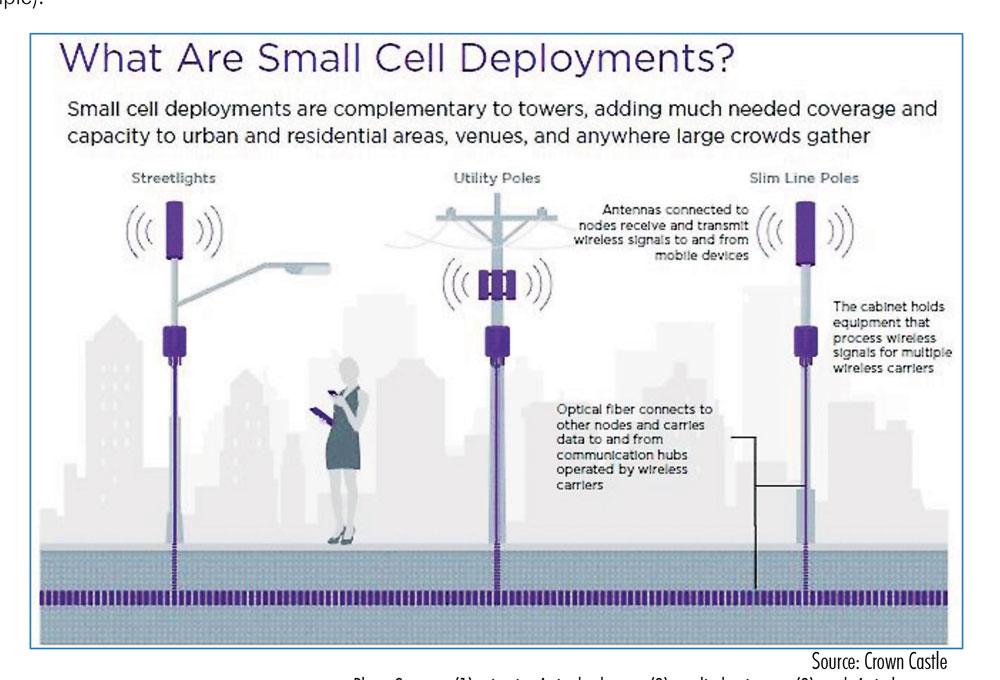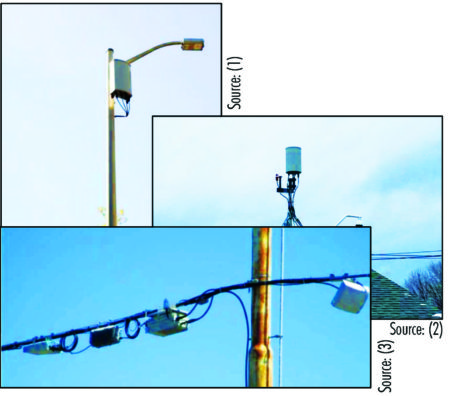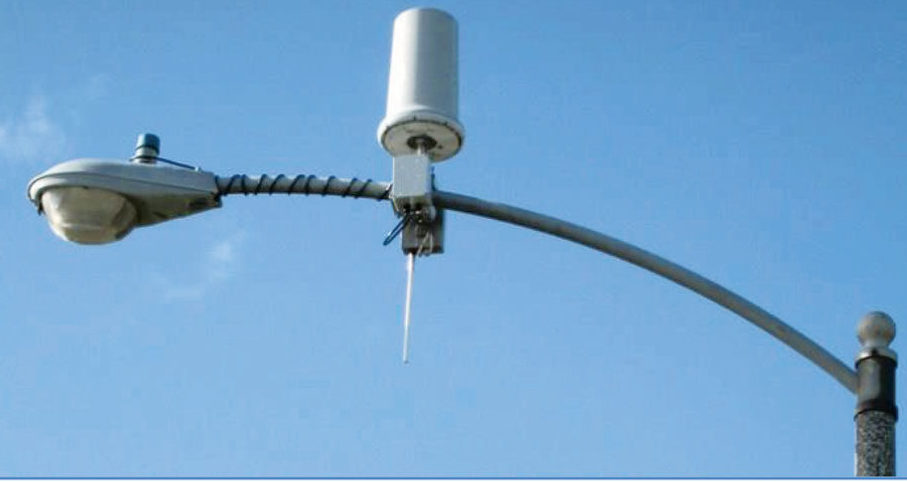
Denver has been receiving a growing number of requests from wireless providers and wireless infrastructure companies to construct small cell facilities in the public right of way. This graphic is from “Small Cell Infrastructure in Denver,” a September 2017 publication by Denver Public Works.
Cell towers began popping up across the landscape in the mid-’90s. Now, as wireless communications continue to evolve, “small cell” installations will proliferate on city streets. The cause? Massive increases in mobile data demands and the need to densify networks. Verizon representatives say industry projections are for a fivefold increase in data demand by 2021.

Photo Sources: (1) scientists4wiredtech.com; (2) steelintheair.com; (3) wade4wireless.com. Small cell antenna equipment is typically the size of a small to medium suitcase and can be located on utility or street lighting poles, strung on wires between poles, or on new freestanding poles in the public right-of-way. The equipment can also be mounted on existing buildings on public or private property.
Quoting from a city of Denver fact sheet, “To meet the demands for wireless data, carriers have begun using new lower-powered antenna technology to ‘offload’ data traffic from the larger cell towers. Each of these smaller antennas serves a much smaller area (1–2 blocks) but with much higher data volumes. This type of wireless infrastructure is referred to as ‘Small Cell.’” The city expects hundreds, if not thousands, of these new installations in the next few years. By contrast, Aurora anticipates the number of such facilities to number in the dozens. The small cell equipment will initially meet current 4G (LTE) voice and data demands but it may be modified with future 5G higher-speed equipment as technology changes.
Small cell antenna equipment is typically the size of a medium suitcase and must be under 20 cubic feet in total volume including an antenna, radio, power source and optical fiber connections. The size limitation is set by state law; House Bill 1193 passed in the 2017 session. Its major thrust is to create an expedited permitting process and to mandate the right of telecommunications providers to locate the small cell facilities on a local government entity’s utility poles, traffic signal poles or on wires between poles.
So, whereas the “macro” towers of a generation ago were generally located on private property (and thus, subject to zoning), the small cell facilities will tend to be located in public rights-of-way, i.e., streets.
Both Denver and Aurora will push colocation as much as possible, with a goal of multiple carriers per pole—and both will require applicants to notify adjacent property owners and registered neighborhood organizations.
In Denver, a total of 56 applications from three providers are in various stages of review and approval. Only one application, 845 Yosemite St. in Lowry, is located within the Front Porch distribution area. Verizon representatives would not commit to when applications might be submitted in northeast Denver but left no doubt that the need for network densification will include this part of the city.
One complication is that the vast majority of utility poles in the public right-of-way are owned by Xcel. Even where poles are owned by a municipality, they may be occupied by traffic signals and emergency service equipment, making them unsuitable for small cell installation. So, carriers, the municipalities and Xcel are engaged in an elaborate negotiation now to reduce pole clutter, avoid negative impacts on police and fire communications equipment, and find ways to have the new facilities blend into the streetscape as much as possible.
It is unclear how successful they will be. The Denver Public Works website says, “Under current law, it is not clear how the City can restrict height, design or location … of Small Cell infrastructure.” However, Denver has some general design requirements in place for small cell equipment and is considering additional design guidelines. Aurora representative Hector Reynoso says, “We are really limited in our ability to regulate these new facilities. The city can’t say no to facilities in the right-of-way. To minimize the number of new poles is our priority.”

A “colocated” small cell installation placed on a street light yardarm. Street lights in Denver are typically owned by Xcel.
Xcel spokesperson Mark Stutz says his company has “historically allowed communications equipment to be attached to its electric distribution poles throughout its service area (including Denver) and has had agreements in place with multiple wireless carriers to allow the carriers to colocate ‘small cells’ on Xcel Energy’s distribution poles since 2015, when wireless carriers were planning their first small cell deployments.”
“Since then, upon discussion with the cities/communities … that it serves, Xcel Energy has decided to make additional company-owned infrastructure available for the colocation of small cells and is working on finalizing agreements with various wireless carriers that would further reduce the need for additional infrastructure in the right of way to support the carriers’ small cell deployments.”
Hector Reynoso, Aurora’s real property manager, says he expects the basic installation to be a five-foot “silo” atop a 30-foot pole. Aurora rejected the initial set of small cell applications because of conflicts with emergency service equipment. Reynoso expects applications citywide in the coming months.
Verizon spokesperson Meagan Dorsch said her company supported the 2017 legislation to “modernize and streamline the permitting process” and its provisions for “local government oversight.” The new state law requires permits to be processed in 90 days or less.




Here are some you missed in the area being installed.
Verizon proposes a 2nd Submittal for 10 8 Small Cell Facilities and Towers at the following addressable locations:
1) DEN Colfax SC1 – 1498 N Verbena St.; 30’ 1”
2) DEN Colfax SC2 – 1504 N Tamarac St.; 30’
3) DEN Colfax SC3 – 1498 N Rosemary St.; 30’ 1”
4) DEN Lowry SC1 – 9210 E Alameda Ave.; 30’ 1”
5) DEN Lowry SC2 – 8910 E Alameda Ave.; 30’ 1”
6) DEN Lowry SC3 – 8303 E Alameda Ave.; 30’ 1”
7) DEN Lowry SC4 – 7355 E Lowry Blvd.; 30’ 1”
8) DEN Lowry SC5 – 401 N Quebec St.; 30’ 1”